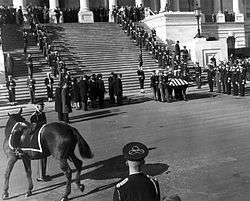Riderless horse

A riderless horse (which may be caparisoned in ornamental and protective coverings, having a detailed protocol of their own) is a single horse, without a rider, and with boots reversed in the stirrups, which sometimes accompanies a funeral procession. The horse follows the caisson carrying the casket.[1] A riderless horse can also be featured in military parades to symbolize fallen soldiers. In Australia for example, it is traditional for a riderless horse known as the 'Lone Charger' to lead the annual Anzac Day marches.[2]
History
The custom is believed to date back to the time of Genghis Khan, when a horse was sacrificed to serve the fallen warrior in the next world. The riderless horse later came to symbolize a warrior who would ride no more.[3]
In the United States, the riderless horse is part of the military honors given to an Army or Marine Corps officer who was a colonel or above; this includes the President, by virtue of having been the country's commander in chief and the Secretary of Defense, having overseen the armed forces. Alexander Hamilton, former Secretary of the Treasury (1789-1795) was the first American to be given the honor. Historian Ron Chernow noted that Hamilton's gray horse followed the casket "with the boots and spurs of its former rider reversed in the stirrups."[4] Abraham Lincoln was the first president of the United States to be officially honored by the inclusion of the riderless horse in his funeral cortege,[1] although a letter from George Washington's personal secretary recorded the president's horse was part of the president's funeral, carrying his saddle, pistols, and holsters.[5] Traditionally, simple black riding boots are reversed in the stirrups to represent a fallen leader looking back on his troops for the last time.
Notable horses
Old Bob
In 1865, Abraham Lincoln was honored by the inclusion of a riderless horse at his funeral. When Lincoln's funeral train reached Springfield, Illinois, his horse, Old Bob, who was draped in a black mourning blanket, followed the procession and led mourners to Lincoln's burial spot.[6]
Black Jack

A notable riderless horse was "Black Jack," a half-Morgan named for General of the Armies John "Black Jack" Pershing. Black Jack took part in the state funerals of Presidents John F. Kennedy (1963),[7] Herbert Hoover (1964), and Lyndon Johnson (1973), and General of the Army Douglas MacArthur (1964).[8][9]
Black Jack was foaled January 19, 1947, and came to Fort Myer from Fort Reno, Oklahoma, on November 22, 1952. Black Jack was the last of the Quartermaster-issue horses branded with the Army's U.S. brand (on the left shoulder) and his Army serial number 2V56 (on the left side of his neck). He died on February 6, 1976, and was buried on the parade ground of Fort Myer's Summerall Field with full military honors, one of only two US Army horses to be given that honor.[10]
Dolly
"Dolly", was the 22 year old charger (whose official name was Octave) of Admiral of the Fleet The Earl Mountbatten of Burma in his capacity as Colonel of the Life Guards. Following the assassination of Lord Mountbatten by the IRA in Mullaghmore, Dolly served as the riderless horse in the funeral procession being led ahead the head of the gun carriage with the Lord Mountbatten's boots (from his Colonel's uniform) reversed in the stirrups on 5 September 1979.[11]
Sergeant York
"Sergeant York" was formerly known as "Allaboard Jules", a racing standardbred gelding. He was renamed (in honor of famous WWI soldier Alvin C. York) when he was accepted into the military in 1997. He served as the riderless horse in President Ronald Reagan's funeral procession, walking behind the caisson bearing Reagan's flag-draped casket.[12]
He was foaled in 1991, sired by Royce and out of the mare Amtrak Collins sired by Computer. He is a descendant of the great standardbred racing stallions Albatross, Tar Heel and Adios.
See also
References
- 1 2 "Customs of Military Funerals Reflect History, Tradition". United States Department of Defence American Forces Press Service. Retrieved 28 April 2010.
- ↑ "The lone charger". Australian War Memorial. Retrieved 4 December 2012.
- ↑ "Riderless horse adds poignancy to military burials". CNN.com. May 23, 2008. Retrieved 30 March 2014.
- ↑ Chernow, Ron (2004). Alexander Hamilton. New York: Penguin Press. pp. 710–712. ISBN 978-1-59420-009-0.
- ↑ "Arlington’s Ceremonial Horses and Funerals at the White House" (PDF). White House History.org. Retrieved 28 April 2010.
- ↑ Knuckle, Robert (2002). Black Jack: America's famous riderless horse. General Store Publishing House. p. 4. ISBN 9781894263658.
- ↑ "The Last Salute: Civil and Military Funeral, 1921–1969 – Chapter 23 – The Last Salute". history.army.mil. 24 May 2005. Retrieved 28 April 2010.
- ↑ "The Old Guard — Caisson Platoon". Army.mil. Retrieved 2010-04-28.
- ↑ Barakat, Matthew, "Riderless horse will symbolize the nation's mourning", Daily Breeze, Torrance, California, June 9, 2004. pg. A.10.
- ↑ Belcher, Nancy Hoyt, "Arlington Cemetery, Fort Myer pay homage to the military", The Record, Bergen County, N.J.: April 6, 2003. pg. T.03.
- ↑ 1979: Mountbatten buried after final parade
- ↑ "Sgt. York's Solemn Trek". Daily News. New York.